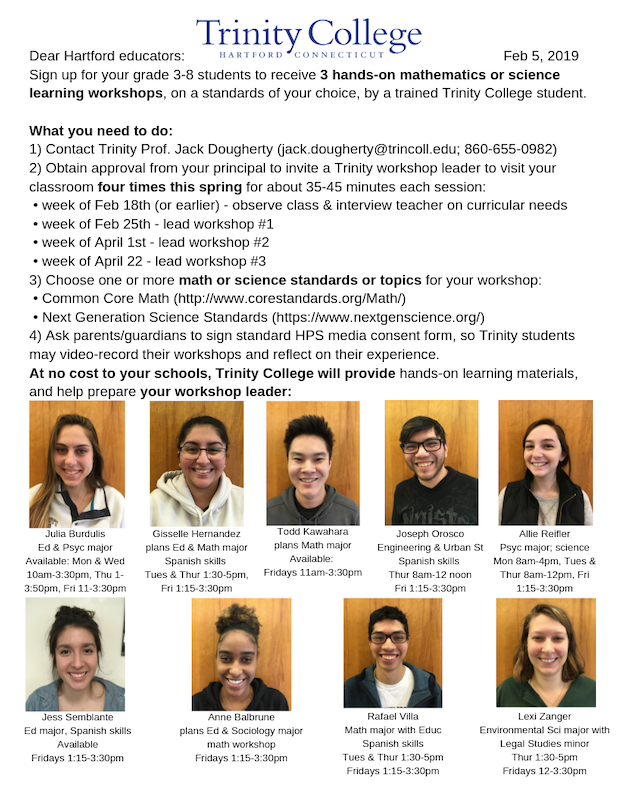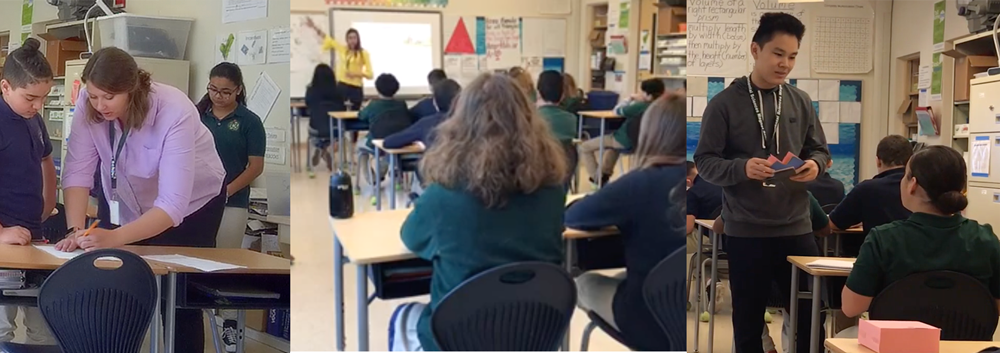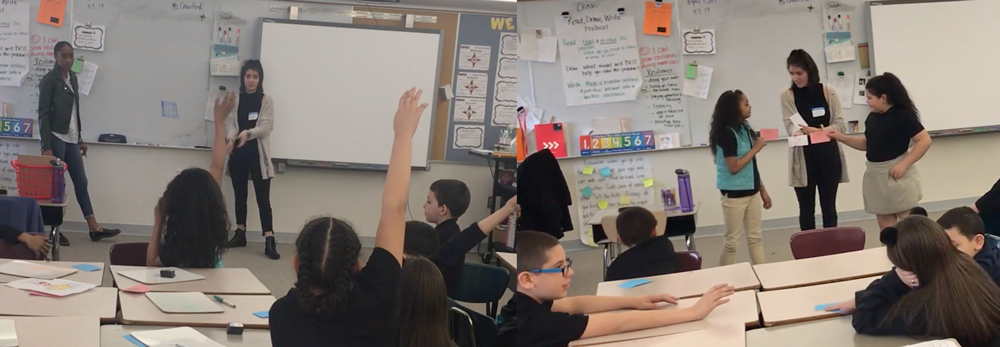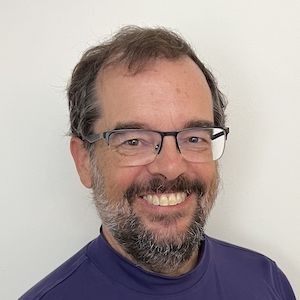Facing the Mirror: Writing the Essay Assigned to My Educ 350 Students
This semester I co-taught Educ 350: Teaching and Learning with Kyle Evans, visiting assistant professor in mathematics. We guided nine Trinity students on designing, teaching, and assessing learning inquiry-based math and science workshops in Hartford schools and after-school programs for 4th thru 8th grade students. Throughout the semester, our Trinity students have been creating web portfolios of their teaching lessons, including curricular materials, video clips from their classrooms, and personal reflections on the experience and what they would do differently next time. To conclude the semester, we assigned our students to write a personal “Teaching and Learning Trajectory” essay on their websites, to reflect on their personal growth as an educator from the beginning to the end of the semester. To help our Trinity students better understand our expectations for this writing assignment, Kyle and I decided to place ourselves in their roles, by facing into the mirror and writing our own teaching and learning trajectory essays about our reflections on teaching this seminar in Spring 2019
I first taught Educ 350: Teaching and Learning in Fall 2007, so this is only my second time (or perhaps the third, if you count a 3-student independent study I supervised in Spring 2016). If often tell colleagues that it takes me at least three times to teach a new course before it begins to feel like it’s working, so this one is still in the adjustment phase. How has my teaching changed, and what have I learned about myself and my students in this journey? This essay offers a closer look at these elements:
- our student objectives, learning activities, and assessment of what we achieved
- my relationships with students as they become educators
- what I learned from co-teaching with a newer faculty colleague
Objectives, Activities, and Assessment
When I teach students about curriculum design, my advice boils down to: “Align your student objectives with your learning activities with your assessment strategy.” In other words, make sure that you’re actually assessing what you originally planned students should learn. So my first step in this reflective essay is to test whether or not I followed my own teaching advice. Back in December/January, before our class began, Kyle and I identified three primary student learning objectives:
- Students will gain contextual understanding of K-12 teaching by comparing different national standards, modes of assessment, equity issues, and pedagogical approaches.
- Students will design and teach inquiry-based math and/or science lessons in upper-elementary classrooms, and evaluate their own teaching and also work by peers.
- Students will develop web authoring skills to create an online teaching portfolio that demonstrates their curriculum design and reflections on their teaching experience.
Looking back, these three goals seem satisfactory, and certainly represent what Kyle and I believed what we reasonably could achieve during one semester with students who in general had no prior experience leading a classroom. But when applying the same standards to myself as I do to my students’ work, I now realize that the 3rd learning goal is actually a learning activity, not an objective that emphasizes higher-level thinking. Next time I would replace it with language that emphasizes something more like this: “3. Students will construct web portfolios that illustrate their teaching plans and actual experiences, evaluate their decisions, and reflect on their personal learning.”
Regarding the learning activities that Kyle and I designed for our Educ 350 class, I’m proud of some decisions we made, but would revise others in the future. Overall, the best learning activity was the Community Learning component. We partnered with teachers/coordinators in 4 Hartford classrooms or after-school programs, who allowed our Trinity students to design and lead math and/or science workshops for their 4th thru 8th grade students. Many thanks to Kristen Crawford (math teacher at ELAMS elementary school), Amy Dougan (science teacher at McDonough Middle School), Adam Smith (math teacher at Environmental Science Magnet School), and Beatrice Alicea (program manager at the J-Z Academic Mentoring Program with Hartford Magnet Trinity College Academy). Organizing these placements was more challenging than in prior years, as my first round of email invitations did not succeed. My second round of door-to-door recruiting worked better, perhaps because we reframed our request as “leading workshops” rather than teaching classes (which are novice students were not yet qualified to do), and perhaps because we personified the request by including photos and descriptors of our Trinity students in the handouts.

Our Trinity students grew as educators during the semester, and documented their transformations in web portfolios that featured their lesson plans, video clips from their classrooms, and reflections on what they would change next time. Originally, Kyle and I planned for our students to design and teach two sessions of about 45-60 minutes each. Fortunately, we juggled the schedule to extend this to three sessions from February through April, to provide more opportunity for growth and reflection. Kyle and I also emphasized inquiry-based learning, which we consciously taught by modeling sample math and science lessons with our students at the beginning of the semester. Several students embraced and applied these concepts to their workshops, which they explain in more detail on their individual web portfolios in the links below.
 Joseph Orosco ‘19 and Allie Reifler ‘21 built connections between food webs, population ecology, and biodiversity for Ms. Amy Dougan’s 7th grade science class at McDonough Middle School. See Joseph’s web portfolio for his lesson that drew parallels between population ecology and computer games that require users to manage scarce resources. See Allie’s web portfolio for her lesson that made biodiversity networks in the faraway Galapagos Islands more tangible by using yarn to “string” together students to represent interdependent relationships between different species.
Joseph Orosco ‘19 and Allie Reifler ‘21 built connections between food webs, population ecology, and biodiversity for Ms. Amy Dougan’s 7th grade science class at McDonough Middle School. See Joseph’s web portfolio for his lesson that drew parallels between population ecology and computer games that require users to manage scarce resources. See Allie’s web portfolio for her lesson that made biodiversity networks in the faraway Galapagos Islands more tangible by using yarn to “string” together students to represent interdependent relationships between different species.
 Lexi Zanger ‘19, Julia Burdulis ‘21, and Todd Kawahara ‘22 invented geometry lessons for Mr. Adam Smith’s 6th grade math class at Environmental Science Magnet at Mary Hooker School. See Lexi’s web portfolio for her lesson on measuring surface area to “prank” Mr. Smith and cover his desk in wrapping paper. See Julia’s web portfolio for her lesson on calculating the area of triangles and parallelograms for students to create their own imaginary zoos. See Todd’s web portfolio for his lesson on estimating the volume of the Traveler’s Tower in downtown Hartford.
Lexi Zanger ‘19, Julia Burdulis ‘21, and Todd Kawahara ‘22 invented geometry lessons for Mr. Adam Smith’s 6th grade math class at Environmental Science Magnet at Mary Hooker School. See Lexi’s web portfolio for her lesson on measuring surface area to “prank” Mr. Smith and cover his desk in wrapping paper. See Julia’s web portfolio for her lesson on calculating the area of triangles and parallelograms for students to create their own imaginary zoos. See Todd’s web portfolio for his lesson on estimating the volume of the Traveler’s Tower in downtown Hartford.
 Anne Valbrune ‘21 and Jess Semblante ‘21 paired up to lead a series of math workshops for Ms. Kristen Crawford’s 4th grade class at the Expeditionary Learning Academy at Moylan School (ELAMS). See Anne’s web portfolio for her lesson on representing fractions and decimals in numerical and pictorial formats (which led students to debate whether 0.8 and 0.80 were the same or different). See Jess’s web portfolio for her lesson about acute/obtuse angles, shapes, and symmetry across three hands-on learning stations.
Anne Valbrune ‘21 and Jess Semblante ‘21 paired up to lead a series of math workshops for Ms. Kristen Crawford’s 4th grade class at the Expeditionary Learning Academy at Moylan School (ELAMS). See Anne’s web portfolio for her lesson on representing fractions and decimals in numerical and pictorial formats (which led students to debate whether 0.8 and 0.80 were the same or different). See Jess’s web portfolio for her lesson about acute/obtuse angles, shapes, and symmetry across three hands-on learning stations.
 Rafael Villa ‘21 and Gisselle Hernandez ‘22 created math and science workshops for the JZ-Academic Mentoring Program with 8th grade students from Hartford Magnet Trinity College Academy, led by Beatrice Alicea. See Rafael’s web portfolio for their lesson about designing water rockets, which asked students to build different fins and nosecones to test how these variables affected the height reached by their rockets. See Gisselle’s web portfolio for their math and art lesson that taught concepts of rotation and translation to create tessellations.
Rafael Villa ‘21 and Gisselle Hernandez ‘22 created math and science workshops for the JZ-Academic Mentoring Program with 8th grade students from Hartford Magnet Trinity College Academy, led by Beatrice Alicea. See Rafael’s web portfolio for their lesson about designing water rockets, which asked students to build different fins and nosecones to test how these variables affected the height reached by their rockets. See Gisselle’s web portfolio for their math and art lesson that taught concepts of rotation and translation to create tessellations.
During the semester, Kyle and I made changes to our syllabus to address what we felt students were not learning as fully as we had hoped during their first two teaching sessions. Teaching Trinity students how to meaningfully assess their student learning was challenging, as it is for any new teacher. In the final weeks of the course, we emphasized a new theme: “Show Us the Learning” (which I adopted from Mills Kelly at George Mason University). First, we encouraged students to think more creatively about how to quickly capture examples of student work, or to reconstruct dialogue about questions that students asked or concepts they grappled with in their workshops. Second, we introduced more techniques for quickly capturing what students learn through short individualized formative assessments that are directly tied to the lesson objectives. While I’m glad that our syllabus was flexible enough to add these extra activities, it also shows that our initial activities on assessment may not have been sufficient, since many of our Trinity students did not fully incorporate these into their first or second workshops. So next time I teach this class, it’s an area for improvement.
Relationships with students as they become educators
Mid-way through the semester, Georgina Rivera from Bristol Public Schools visited our seminar and led a workshop on teaching about mathematics and equity. She led us through an inquiry-based lesson, “The File Cabinet Problem: A Three-Act Task” (and definitely check out the last slide for extensive links to other curriculum materials). But I was equally impressed by how she emphasized the importance of building relationships with students, and demonstrated this by having us stand together in the front of the room for a group activity. I fully agree that meaningful learning and teaching is built on a foundation of relationships between students and teachers. But I’ve never found a good way to teach that concept in a classroom like Educ 350. Simply telling people that “relationships matter” so easily becomes empty words. In my experience, educators need to continually show students how we care about their learning.
So I’m still reflecting on Georgina Rivera’s visit and what it means for my personal trajectory. Teaching – when you really put your heart into it – is hard work, both intellectually and emotionally. When I work with new teachers, I tend to focus primarily on the intellectual side, such as planning a well-designed lesson and aligning your objectives – activities – assessments. Furthermore, newer teachers tend to focus on the “performance” of teaching at the front of a classroom, and when they get past those first-day jitters, my aim is to help them focus on student learning, hence the “show us the learning”.
But I need to find better ways to focus on the less-visible aspects of teaching. Most college students have been socialized for over a dozen years to focus on their own individual learning: finishing your homework, taking your test, improving your grades. But when they step into their new roles as educators, their success depends on caring about the learning of other people. In other words, teaching requires us to be less self-oriented, and more attuned to the needs, differences, and growth of people around us. This work can be both emotionally draining (as you pay more attention and devote more of your time to other people) and deeply fulfilling (as your sense of purpose grows to become larger than just you). That’s the primary reason why I teach Educ 350 to Trinity College students: to help them redefine ‘education’ beyond simply raising their individual GPA, to the broader realm of caring and taking appropriate actions to help other people grow.
A second reason why I teach Educ 350 is the difference between analysis and synthesis, or to put it into simpler terms, breaking and building. Most of the courses I teach at Trinity focus on analyzing education, or intellectually breaking it down into different parts to better understand the relationships between them. For example, my Ed Studies colleagues and I named our introductory course Educ 200: Analyzing Schools because we take apart the classroom education process, layer by layer, to ask questions that theorists have long asked, such as: How does the organization of schools shape interactions? How does learning happen? What causes educational inequalities? By contrast, the Educ 350 seminar works in the opposite direction by synthesizing, or bringing together different pieces of the teaching and learning process to create something new. In Educ 350, we ask our students questions such as: How can you construct a lesson that builds on students’ prior knowledge and leads them to make new discoveries? What meaningful learning experiences can you co-create with your students in their Hartford classroom? How can you show us that learning happened in your web portfolios? Of course, Educ 350 does not entirely leave behind the act of analysis. For instance, when we ask Trinity students to better align their objectives, activities, and assessment in their lessons, that requires them to mentally take apart their lessons and adjust the pieces to better fit together. But overall, teaching Educ 350 motivates me because it places me in a different role, to help students become pedagogically creative, and synthesize new lessons, rather than only analyzing and taking ideas apart.
Lessons Learned from Co-Teaching at Trinity
Three quick lessons I learned from co-teaching this course with Kyle Evans, a first-year faculty member in Trinity’s Mathematics Department:
- To my Trinity faculty colleagues: if you haven’t yet co-taught a course, you should definitely try it, because it pushes you to rethink some assumptions and articulate why you believe in certain pedagogical strategies, or ways of interacting with students.
- Co-teaching also offers you a second opinion about how to deal with complex situations, which inevitably arise in teaching
- Kyle keeps a plentiful supply of chocolate in his office, which entices people to come meet with him. But I didn’t realize this until the end of the semester, because I grew accustomed to scheduling our meetings in my office, and never suggested that we meet at his office until he brought it up. If I had known about the chocolate, I would have changed my ways much sooner.
